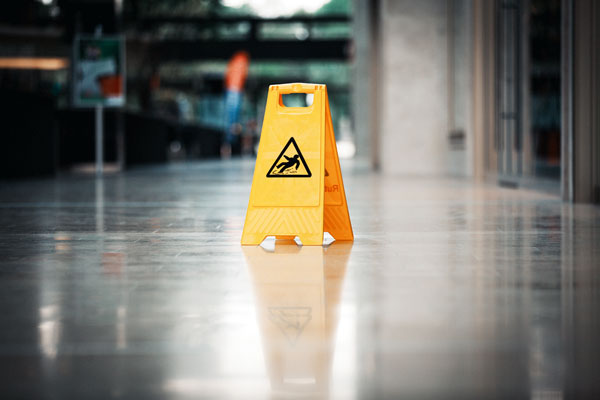05 Nov Safety Tips: Slips, Trips and Falls
If I’m a business owner without a program for slip and fall prevention, where should I start?
If you’re a business that wants to be more safety conscious – you need to be addressing slips, trips, and falls in your safety plan. Slips, trips, and falls are the number three cause of accidental death in this country, most of them occurring on the same level (i.e. not on stairs or platforms).
 Tim McCarty, Director of Safety & Risk Consulting Services at Clark Insurance recently took the stage with Peter Koch, Safety Management Consultant at MEMIC to present: “The S.A.F.E. Way Out of Slips, Trips, & Falls” at the 2018 Maine Safety & Health Conference. They spent a full day discussing people’s awareness, footwear, the general environment, and how this all affects the likeliness and severity of slips, trips, and falls. Below is an interview with Tim we conducted after the event – condensing the key takeaways from his presentation for those who did not attend.
Tim McCarty, Director of Safety & Risk Consulting Services at Clark Insurance recently took the stage with Peter Koch, Safety Management Consultant at MEMIC to present: “The S.A.F.E. Way Out of Slips, Trips, & Falls” at the 2018 Maine Safety & Health Conference. They spent a full day discussing people’s awareness, footwear, the general environment, and how this all affects the likeliness and severity of slips, trips, and falls. Below is an interview with Tim we conducted after the event – condensing the key takeaways from his presentation for those who did not attend.
Q: What is the most important thing that small business owners should know regarding slips, trips, and falls?
A: “When there is an incident people tend to make a big deal out of it and start coming up with elaborate mitigation plans. In some cases that’s necessary but slips, trips, and falls can be solved pretty simply. Awareness of potential problems and taking the simple steps to correct it will generally solve the issue – and if you need help, ask for it. That’s why I’m here.”
Q: What are the most common causes of slip, trip, and fall claims?
A: “55% of the time, the cause is the walkway surface providing inadequate traction. So working to improve traction will have the biggest impact. If you can, it’s best to make sure that employees have adequate footwear with a high-traction sole, but if your business is open to the public you don’t have that kind of control. In that case, the biggest thing we can do is keep floors clean and well-maintained. Most of the time, just cleanliness and proper maintenance will resolve the problem.”
Q: If I’m a small business owner without a program for slip, trip, and fall prevention, where should I start?
- “The first step is awareness of the issue and investigation. If you take a look at your flooring surfaces and you can get a feel for them – are they slippery? It’s not scientific but that’s a good indication. If there’s a place where people have fallen, that is something that you should really take a look at. Is the floor greasy or smooth enough that it might be a problem?In addition, an important step that many business owners forget is talking to their employees. They are on the front lines, so they know exactly where the slippery spots are, or where a piece of equipment is leaking that is causing a slippery situation. Your employees are your best resource – talk to them.”
- “The next step is prevention. Clean, dry floors are not where people are going to slip and fall. It’s when they are wet or contaminated (with water, snow, ice, grease, or other contaminants) that people are going to fall. We want to reduce the introduction of contaminants into the workplace – so walk–off mats at entrances and exits are a great solution. It’s important that the mats are cleaned and maintained properly because an unclean mat will collect contaminants and then introduce them to the clean soles of the shoes of people who walk on the mats, which will just make traction worse.”
- “The last step is the walkway surface cleaning and maintenance process. Make sure that you are cleaning your floors with a clean mop head. Ensure that the right cleanser for the flooring material is being used, and it’s being completely rinsed off so a residue isn’t being left behind. Improper cleaning solutions and residues on your floor will reduce their traction, increasing the likelihood of slips, trips, and falls.”
Q: Finally, if my business has slippery floors installed, is there anything I can do about it – short of installing new ones?
A: “The best thing you can do is have appropriate cleaning protocol. There are high-traction finishes that you can utilize. The biggest caution there, is that you should work with your flooring distributor to make sure you have the right product for the type of flooring you have.”
Read more about Safety & Risk Consulting, and to continue the conversation see the following resources and contact Tim McCarty.




